|
FAQs about Isopod
Identification
Related FAQs: & FAQs on: Isopods 1, Isopods
2, & Isopod Control,
Isopod Reproduction... & Crustacean
Parasitic Disease, Parasitic Disease
1, Parasitic Disease 2,
Parasitic Disease 3, Parasitic Disease 4, Parasitic Disease 5, Parasitic Disease 6, Parasitic Disease 7, Micro-Crustaceans, Amphipods, Copepods, Mysids, Hermit
Crabs, Shrimps,
Cleaner
Shrimps, Banded Coral
Shrimp, Mantis
Shrimp, Anemone
Eating Shrimp, Crustacean Identification, Crustacean Selection, Crustacean Behavior, Crustacean Compatibility, Crustacean Systems, Crustacean Feeding, Crustacean Disease, Crustacean Reproduction,
Related Articles: Isopod
Crustaceans, Crustacean Parasitic Disease,
Shrimp,
|

|
|
Identify parasite
1/26/15
Hi crew!
I'm in need of professional advice identifying something that has been
attached to my clownfish. A little background: this was attached
to a clownfish that I've had since August. All of my fish go
through a quarantine protocol of tank transfer, followed by a treatment
of PraziPro
<Only useful for worms>
then followed by a month of observation in a cycled quarantine tank. All
inverts (and anything else wet) goes through 11 weeks in a cycled
quarantine tank (not the same as the fish). My reef tank has been
running for 10 years.
None of my fish are exhibiting symptoms of any parasites, no heavy
breathing, no flashing, piping, appetite is excellent, etc. As a matter
of fact my clown fish laid eggs the other day but I saw this thing on
her that looks like a skin tag. I did a FW dip in her
but it did not come off. I ended up putting her on a dissection tray and
pulling the thing off with a pair of tweezers. I took pictures of it on
my microscope. The Mag was 4x. It appears whatever it
is was killed by the FW dip but I am not able to identify what it is. It
doesn't appear to be a fluke, maybe some kind of isopod or
amphipod?
<I do think the former... IS a crustacean... appears to have legs that
are "all about the same" ('iso')... Do see WWM re these not-fun
rolly pollies... and their control. Likely your physical removal is the
end of them here>
Any help would be very appreciated. Thank you. Jennifer
<Do you need help using the indices, search tool? Bob Fenner> |
.jpeg)
.jpeg) |
Re: Identify parasite
1/27/15
Bob,
Yes, I do know how to use a search engine. The attached object looked nothing
like the images on that page. The one on my fish was clear, no eyes, or even
discernible legs.
<I see the eye, remnants of legs and even eggs here>
It actually looked like a skin tag or a raised scale.
Jennifer
<Could be something else; but my guess is still on an Isopod. BobF> |
Isopod help!! Rdg.
2/27/14
Hi Bob, I am hoping you can help, I found this and think it's an isopod!
<Appears to be>
I am wandering how you can Identify if it is a shrimp of a fish predator?
<Need better image/s. Read here:
http://www.wetwebmedia.com/isopodid.htm
and the linked files above>
This was in our quarantine tank,
<Ah good>
I am a bit concerned as had to put all livestock in here late December due
to a tank leak! Would any symptoms of them being present in the main system
be present by now?
<?>
None of the fish have ulcers and I haven't seen them on any of our fish!
How do you get rid of them? Your help is much appreciated.
<Read. Bob Fenner>
Isopod 2/27/14
Here is a couple more pics of the isopod!
<Ditto> |
.JPG) .JPG) |
Re: Isopod help!!
2/27/14
I think it is a Sphaeromatid as the eyes are on the side of the head not the
top, it could also roll up!
<Possibly...>
Is there a big difference between the males and females tail? Thank-you!
<Not much. B> |
Isopod parasite 11/29/13
I have just removed a half inch isopod from the buccal cavity of my
forktail
blenny. They blenny was suffering from swelling in the area and labored
breathing and so my LFS suggested a freshwater dip as a last resort to
see what was wrong. The copper and Prazi-pro I had previously tried
treating this fish with seem to have little effect as the "lump" (now
confirmed as an isopod) continued to grow. To my horror this giant
(compared to the fish) thing tried backing its way out my fishes gills
during the dip.
Sadly it was too large for this and became jammed in. I was forced to
extract it with tweezers in an attempt to allow the fish to breath. The
fish survived the initial removal but was either too stressed or had too
much gill damage. He is now barley hanging on and I don't believe he
will survive. I am very concerned about my other fish. Everything
I am reading is either about external isopod parasites or the one that
eats the tongue. I am hoping one of the crew may know more about this
buccal cavity isopod and what I should do to spare my other fish from
this horrible ordeal.
<Nothing really>
I am not even sure if they are infected or if this was a one time thing
but I do not want to lose any more fish.
A very sad and horrified,
Jen
<Buccal cavities are not strange places for some isopod parasites...
great placement for water movement, protection from predators and foods!
Due to their life cycle requirements there is not much chance that
others are inhabiting or likely to infest your other fishes. Bob Fenner>
Re: Isopod parasite 11/30/13
Thank-you very much. I tried to find out more about what type of isopod
this was but quickly found out that classifying these creatures takes a
lifetime of study.
<Classifying perhaps; but identification not a big deal...>
The best I could do is that it is from the family of Aegid. I will be
replacing my blenny with a captive bred individual so that
I don't have to deal with the chance of another one of these coming in
with a wild caught fish.
Jen
<Yes; BobF>
|
Puffer parasite?? 12/7/12
We have a new golden puffer for about 4 months now with no issues..
All of the sudden tonight when we went to feed them he had these rice like
"parasites" all over his body and one of his eyes.
None of the other fish in the tank have any signs of this and he is acting
normal so far.
Any ideas?
<Have tried enlarging some of these "zots" and enhancing the image... They
look like congealed spots of body mucus more than anything discrete; not
like a live organism. Tetraodonts are quite slimy and often particulates
will adhere to them... I'd review what your water quality, any supplements,
treatments you've added to the water... and not treat this fish/system in
any way. Bob Fenner>
|
[1]%20(1).jpg)
[1]%20(2).jpg)
|
|
Chiton or Isopod? 12/4/12
<Hello Shaima>
Forgot to add it did curl up when I caught it and float round the tank
in a ball. But when it open upside down it didn't appear to have legs
<It is a Chiton and a useful animal. James (Salty Dog)>
<<Mmm, am almost certain this IS an isopod; on the basis of eyes, color,
behavior...
Please see here re:
http://www.wetwebmedia.com/isopodid.htm
and the linked files above. Bob Fenner>>
|
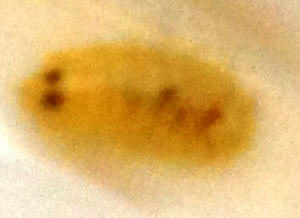
%20isopod.jpeg) |
|
Re: Chiton/isopod?? 12/4/12
Geez, sure looked like a Chiton to me. Sorry.
James
<No worries... I did what I could to crop, enhance the images... And
Chitons are always attached, not free-floating/swimming in the water
column. Cheers, B>
|
|
ID question 10/3/12
Bob
A few of these were found on some corals branches originating out
of Fiji at my shop. Any idea on what species?
Thanks in advance
Marvin VandeLinde
Atlantis Aquarium
Bunk... Isopods... Cirolanids... must destroy... organophosphates...
like Fluke Tabs... B
|
 |
|
Re Isopod Identification 10/6/12
Bob
Hope all is well. We never had a chance to catch up at MACNA. How is
your schedule around the RAP show?
<Marv, have just looked at the RAP schedule online and they don't (!?)
have me scheduled at all... Thought I was going to speak on Sun.. Have
sent an email to them re... am waiting for a resp.>
My wife below has become determined to figure out exactly what the
species is. This is in reference to the pics I send a few days back
Would it be too much for me to ask you to entertain her email:)
<I don't know unfortunately... I'd refer you here:
http://wetwebmedia.com/isopodid.htm
I'd have her send some samples to a university that has a recognized
expert w/ Isopod ID (after securing their okay via the Net, phone) for
real help. BobF>
Much thanks
Marvin VandeLinde
Atlantis Aquarium
Isopod Identification 10/7/12
Isopod is a pretty generic term... but, from these pictures, I'm going
to say they are of the family: Sphaeromatids, harmless scavengers. The
biggest difference between the Sphaeromatids and Cirolanids (the bad
guys) is the tail, which is pretty hard to see in the pictures you sent,
also the placement of the eyes. See the photo I have attached. The
Sphaeromatids (top) have the eyes on the side of their head, where the
Cirolanids are on top, more like a flounder. I think the best way to
tell is that these guys can roll into a ball like a roley poley,
the others don't seem to have that talent. Here are a couple of
links with more info, but I think the fish are safe!
http://www.marinespecies.org/aphia.php?p=taxdetails&id=292950
http://www.crustacea.net/crustace/isopoda/www/sphaerom.htm
http://www.youtube.com/watch?v=hB-PsfKN6Wc
"Sphaeromatids are small bugs, generally less than a centimeter in
length. They are common scavengers in many shallow marine environments,
including coral reefs, and they are harmless to reef aquarium
inhabitants. They can be recognized immediately by a couple of
distinctive characters. First, each individual has the capability to
roll into a ball-like terrestrial pill bug. None of the other isopods
likely to be found aquaria will be able do that. Second, when examined
with a hand lens or magnifying glass, the last pair of appendages of the
males are expanded and extend to the rear, like small rudders or the
fins on a 1959 Caddy. Females lack these extensions, but if some of the
isopods are seen with them, that is usually a good indication that the
rest of them are also Sphaeromatids."
Selected References:
Brusca, R. C. 1980. Common Intertidal Invertebrates of the Gulf of
California. University of Arizona Press. Tucson. 513 pp.
Kozloff, E. N. 1990. Invertebrates. Saunders College Publishing.
Philadelphia. 866 pp.
Kozloff, E. N. 1996. Marine Invertebrates of the Pacific Northwest.
University of Washington Press. Seattle. 539 pp.
McLaughlin, P. A. 1980. The Comparative Morphology of Recent Crustacea.
W. H. Freeman and Co. San Francisco. 177 pp.
Ruppert, E. E. and R. D. Barnes. 1994. Invertebrate Zoology. Saunders
College Publishing. Philadelphia. 1056 pp.
Schmitt, W. L. 1971. Crustaceans. University of Michigan Press. Ann
Arbor. 204 pp.
All photos and images courtesy of Ronald L. Shimek.
--
Michele
|
 |
|
|
Isopod? 3/17/12
Just wanted to make sure this is an isopod before I flush him
down his water grave, thanks.
<Cirolanid Isopod. Be aware that there are likely more.
Link may be helpful in removing the others http://reefkeeping.com/issues/2006-02/bp/index.php
although it looks as if you are pretty good at removal already.
Jordan>
|
|

|
|
Hitchhiking Cirolanid Isopods
8/24/10
Well, seems as though I noticed the first signs of life buzzing
around in my water column last night after adding 30lbs of
Vanuatu LR to the system this weekend. Unfortunately I am all but
certain they are Cirolanid Isopods. I know folks mis-ID these
quite often but I have read hours this evening (Shimek, Plankis,
Melev) and feel pretty certain about the ID.
So, on to the question. I am setting up this 40G breeder/30G
Sump, this is the initial LR I am curing the system with, and
plan to let it sit in the dark from now until New Years to seed
itself. That's four months give or take a week or two, is
this going to be long enough to starve the little buggers
out?
<I'd poison them... with a "medication" for
killing arthropods/crustaceans... Read here re:
http://wetwebmedia.com/crustdisfaqs1.htm
and the Related FAQs file above: Isopods>
Should I bother trying to nuke and pave or trap them since the
system will be without fish for so long? Should I go longer than
four months? Thanks so much for giving this a read, these little
punks have me fairly stressed out. Don't want my new system
to get off to a bad start.
My Best,
Bush Williams
<Bob Fenner>
Re: Hitchhiking Cirolanid Isopods 8/24/10
Thanks Bob, I added some high res photos at this link if your
interested or would like to use them on WWM.
http://www.reefcentral.com/forums/showthread.php?t=1896304
/Bush Williams (iPad)
<Will do so, with credit to you. BobF>
|
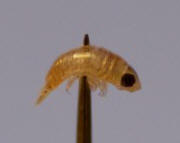 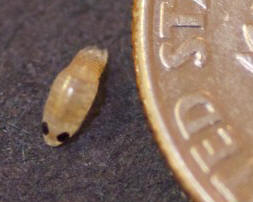 U.S. dime at right U.S. dime at right
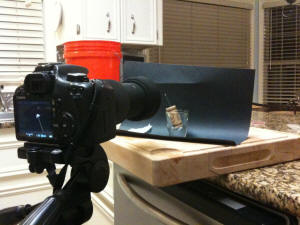 |
|
Red Isopod 12/31/09 Hello, <Hi
there Felicia> It's been a while since I've written. I
have a question today. I bought a Zoanthid rock today with lots
of things on it like Mysids, tunicates, etc. One animal I was a
little concerned about. I found a few of these red Isopods and
I'm worried that they are parasitic on fish. http://img301.imageshack.us/img301/2164/redisopodjz9.jpg
<Mmm, might well be... this looks to be a Cirolanid...> I
caught one and poked it and blew water on it, but it did not roll
up into a ball, so I don't think it is a Sphaeromatid Isopod.
It curled ever so slightly, but swam upside down and then righted
itself to attach to the wall of the container. It is more red
than it appears in the photo, maybe a dark reddish orange. It is
about 3 mm in length. Can you tell if it is parasitic from the
photo and the description? <Is too likely so... I would stay
vigilant... siphon or net out specimens you detect... or pull off
of fishes with tweezers if you detect on their sides or in their
mouths. Bob Fenner>
|
 |
Can You Identify This Species? 8/04/08
We posted this image on our site a while back, but recently had a lady
inquire as to the type of creature exhibited. I did a bit of Googling,
and found nothing to match, which is because, outside of crabs and
lobsters, I'm very ignorant about such things. We'd love to
have someone identify this. If you can, we'll put up your website
in the image description along with the name of the identifier. Thanks
in advance! ~ Jason Paschal P.S. Here's the link to the image on
our site: http://www.imagepoop.com/image/1220/Creepy-Crustacean.html
<Is a deepwater Isopod, maybe Natatolana borealis Bob Fenner... who
didn't copy/post the pic as it is not likely theirs>
|
Parasite on New Cleaner Shrimp - 2/18/08
Hi, Great website by the way! <Thanks, Ed! Its a collective
treasure, isn't it!> I recently purchased a Skunk Cleaner
Shrimp <Lysmata spp.> and I am having some difficulty with
it. It is living in my FOWLR tank on its own and there are some
things I don't understand. <Alright, let's see if we
can't figure them out.> 1) There is a peach coloured,
bubble type of growth on the side of the shrimp, is it a parasite
or will it go at the next molt? <This is a blood-sucking
parasite, generally called a Eucarid or Bopyrid Isopod. We see
them occasionally on shrimp, especially in the genus Lysmata
(cleaner shrimps). These parasites don't come off when the shrimp
molts and they're next to impossible to remove without killing the
host. The growth you see is actually a female isopod that before
it attached, looked like a typical small roly poly isopod. These
organisms attach themselves to a shrimp, bury under the carapace,
and change form into what appears to be a whitish tumor/mass.
Color can vary based on the hue of the overlying carapace. The
good news is that although unsightly, these parasites do not
necessarily kill the host. Nor do they pose a likely threat to
any future shrimps in your system. This is because they require
an intermediate host, a type of copepod, that isn't normally found
in aquaria. One thing of note however, is that although these
don't actually kill the shrimp by themselves, they can weaken it
as well as render it sterile. A shrimp with one of these
parasites attached is not going to be as strong as one without.
Its going to be more susceptible to changes in its environment,
such as water chemistry, etc.> 2) The shrimp appears to be
having some difficulty swimming vertically, and does not get very
far before it sinks, could this be because of the growth?
<Yes, its possible.> 3) I am having trouble feeding the
shrimp. I am trying to feed it Hikari small marine pellets, are
they correct for a shrimp? <My experience is that they'll eat
just about anything: sinking pellets, small meaty bits of marine
origin, flake food, small worms, etc. Just make sure that its
getting a varied diet.> ..and finally, 4) The shrimp never
really seems to venture out when the aquarium lights are on, but
as soon as they are switched off begins exploring the tank, is
there anything I can do to help this? <This may change as the
shrimp becomes more accustomed to its surroundings (as long as no
predatory fish are introduced!). Part of this behavior may be a
function of its slightly weakened state. For example, when
shrimps molt, they instinctively hide because they know they're
vulnerable. Your shrimp could well realize that its not a hundred
percent and be a bit more cautious. For more information/photos
regarding these parasites, please see the following links:
http://www.qualitymarineusa.com/article.asp?page=feature&id=968EF63B-2D1D-469A-847A-8E8541B12BE4
http://home2.pacific.net.ph/~sweetyummy42/hitchshrimp.html>
Thanks for all your help as I am new to marine fishkeeping. Many
thanks Ed. <You're very welcome, Ed! You've come to the right
place! Please let us know if there's anything else we can help you
with. Best wishes to you and your little cleaner shrimp. Take
care, -Lynn>
Re: Parasite on New Cleaner Shrimp
- -02/20/08 <Good morning, Ed!> Thank you
for your help regarding my last shrimpy questions, <You're very
welcome!> ..but after reading the articles on one of your
links, it appears that the parasite (Eucarid) can be removed from
the host shrimp, and that the shrimp will make a full recovery.
<Hmmm, yes, it can be done, but it sounds like a potentially
tricky (and risky for the patient) procedure, particularly if
you've never done it before. You've got to have a pair of very fine
tweezers, or the like, as well as know the anatomy of the shrimp
so that you don't go in at the wrong place. Furthermore, the
shrimp is not anesthetized. You've got to capture it, turn it
upside down and keep it still in that position under water, reach
in at the right spot with fine tweezers. taking care not to
puncture the body during which time, the shrimp is most likely
trying to get away. I've seen reptiles and sharks enter a
sort of catatonic state when they're upside down. Im not sure if
shrimp react similarly. At this point, you have to determine
which is more life threatening the actual parasite or the removal
procedure?> Would you recommend this procedure?
<Personally, I wouldn't do it and wouldn't recommend it.
The shrimp can survive with the parasite and there's little, if
any, risk to the rest of the livestock. More importantly, the
shrimp is a new addition, already dealing with enough stress. Im
not sure it would survive the procedure.> Many thanks again,
Ed <You're most welcome. Take care, -Lynn>
|
|
Good isopod? 02/07/08 Hello, I have been scanning pictures
of isopods for hours, and cannot seem to find any showing the
"pincers".. There is big one in my tank (about 1/2 inch
long), and a bunch of little tiny ones in the refugium. I only
saw the one in the picture once, don't know if I will ever
find it in the tank, to see if it will curl up. The other, tiny
ones are too small to see if they curl up. I was just
"seeding" my new tank with the amphipod pack I had
bought, getting it ready for seahorses. Some of these isopod
pics, with them attached to fish, are scaring me. <If you
think those pics are scary, check this one out:
http://www.siamensis.org/images/webboard_images/picture__reply_35037.jpg
That one still gives me nightmares!> Please tell me that I
have something special.. not a predator in my soon to be peaceful
seahorse tank.. <I'm no isopod expert, but the critter
pictured doesn't look like one of the isopods which prey on
fish. But I honestly don't know quite what it is either. It
looks like it could be something out of the Sphaeromatidae
family, but that's a guess (at best). Some better pictures
would help. Those "pincers" are throwing me off too. If
you can, you might want to remove it just in case.> Have a
GREAT day! <Y tu tambien, Sara M.>
Re: good isopod?-02/08/08 IF I ever see that big one, I
will grab it - and take a better picture, may also try a
Bristleworm trap. I will somehow have to separate them in the
hatchery tank... but now I am afraid some microscopic newly
hatched/ eggs will get in the tank... When one of the tiny guys
gets bigger - I will photo it from the front. I JUST put the
system together, kinda jumped the gun by purchasing a blenny
& goby when the water isn't supposed to be ready yet -
but I did a couple of extra things to make sure the cycling
process was boosted. I bought 2 different macroalgae from people,
that boasted their algae was full of critters. Also live sand
& live rock. Then set up a hatchery for some macro, brine
shrimp, copepods, & amphipods. Twice a day I have been
exchanging 1 cup in each tank.. (wanted to get a healthy
population of live critters for the seahorses to hunt & eat)
<cool> The only possible good thing is - the goby is eating
well - and I saw a picture on the net of the same type goby
eating a Bristleworm that was quite large. I am hoping that will
be the fate of "bertha the unknown bug".. (but the kids
thought he was cute & named him) <LOL I was going to say
something about it being kinda cute for an isopod, but I'm
glad your kids said it first. ;-)> ALSO, the seller got back
to me just now and said, "I have those and several other
types of pods in my system and have never had an issue with them
at all." <Well, that's good news. The truth is that
the majority of these little critters are quite harmless (often
beneficial even). It's just a few evil ones that make people
freak out a little and give the rest a bad name
unfortunately.> Thank you so much for the quick response, and
the many MANY Q&A's that I have already read on your
website! <De nada,
Sara M.>
|
|
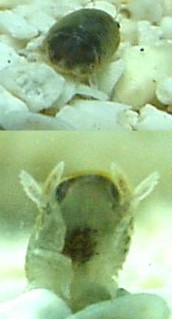
|
Isopods... need better image -
1/24/08 Hi, <Alan> I just noticed these isopods in my
reef tank after deciding to look at the copepods in my tank with a
10x Hastings triplet. These guys are microscopic and I wanted to
know if they are bad Isopods or good Isopods? <Me neither... pic
is too poorly resolved> Can you tell me what kind they are? I
caught a few of them in the camera lens through the magnifier. You
can see the red one pretty clearly but the clear or tan ones are
not so clear. You will see it just below the center of the picture.
Thank You,
Alan
<Can barely make out... BobF> |
|
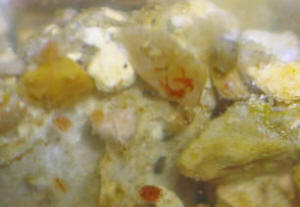
|
|
Question for you, Re: Isopod ID - 1/24/08 Hi Guys, I
sent this question in yesterday but did not realize that the
picture was resized by the email program. Here is the full
picture. These are Isopods that are in my tank. one red one and
some kind of clear. You will find the red one just below the
center of the picture. <A bit better... but...> I want to
know if they are good or bad? <Most of this group/Order is
"not good" to bad for aquariums... too often
predaceous, too infrequently palatable...> I had to photograph
them through a magnifier that was 10x. They are really small. If
you can identify them would you please reply to both email
addresses above. Thanks for the help and I look forward to
hearing back from you. Alan <I'd do what you can to rid
the system of these: Read here:
http://wetwebmedia.com/isopodcontr.htm Bob Fenner>
Re: Question for you, Re: Isopod ID, contr.
1/25/08 Hi Bob, Thanks for the response and the link. I read
the link and some of the methods are for a bigger pod. Since
these are so small do you think the filter floss in both ends of
a baited tube would work? Alan <Worth trying... perhaps a
Stenopid shrimp as well... Bob Fenner>
|
|
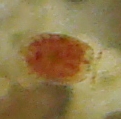
|
Pod ID: Munnid - 12/24/07 Hello,
<Hi there, Jesse.> Happy Holidays, <Right back at you!>
I've tried online and can't get a better ID by myself. Can
anyone tell me if this is an amphipod, copepod, or isopod?
<Isopod in the family Munnidae, commonly called a Munnid. They're
harmless/beneficial little herbivores, less than 5mm in length.
Please see the following links for photo comparison/confirmation,
and general info: Dorsal/top view:
http://wetwebfotos.com/usermedia/high/0/2470_145.jpg
Ventral/underneath:
http://wetwebfotos.com/usermedia/high/0/2470_88.jpg General info
about halfway down this link at "Herbivorous Isopods":
http://www.ronshimek.com/Animal%20Groups%204%20Crustaceans.htm >
My clowns and cardinals do not eat them but they love eating the
little copepods (half a mm and smaller). <Interesting. Munnids
are definitely a food item that fish usually go for.> This pic
shows the unidentified at about 2mm long, they range a half to 2.5
mm. <Yep, most I see are around 2.5mm to 3mm (not including
antennae).> There are hundreds in my 60 gal. tank. I wish I had
a better picture but it's hard to do at that size. <It sure
is!> Could I buy a fish that will eat them to control their
numbers? <Yes, but I wouldn't worry about them. They're harmless
and add to the diversity in your tank.> Thank you,
<You're very welcome!>
Jesse
<Take care. -Lynn> |
|
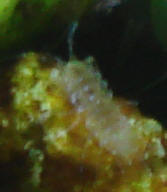
|
| Alaskan Isopod! 11/15/07 <Hi
there!> The students here at our school caught these in our
fresh water river on 11/12/07. <Neat looking little critters,
aren't they?> We live on Alaska's Seward Peninsula on the
Fish River. <What a beautiful area!> Right now it is winter.
Our river has about a foot of ice. <Yikes!> The students
caught about 14 of these 1 inch to 1.5 inch critters, our science
teacher thinks they are isopods. <Correct!> They can swim
right side up and when upside down can swim with the use of some
type of flagella like appendages that are located under the
"tail". <"Pleopods"> When swimming right
side up they seem to use their legs to swim. Here are two photos;
in one the thing is upside down and the other right side up.
<Thank you for the photos, especially for including both views!
Your teacher is right on target. What you have is most likely an
isopod species called Saduria entomon, which is in the family
Chaetiliidae. They are predator/scavengers and serve as a good food
source for Salmon, Cod, and even Gray whales. One thing to note is
that since they are predatory, it would be a good idea to avoid
handling them, as they may bite. Please see this photo link for
comparison:
http://www.acquariodigenova.it/waves/virtual/saduria.htm , as well
as the following, for more detailed information (PDF file):
http://www.sekj.org/PDF/anzf40/anzf40-411.pdf Thank you very much
for writing us, and please let us know if we can be of any further
assistance! -Lynn> |
|
 .JPG)
|
| Two unidentified 'things' and a
Condylactis anemone problem <Hello Anonymous Querior, Mich
here.> I have what I am fearing might be a pest of some sorts,
it resides on the rock with the Zoanthids and the mushrooms. I have
tried to take pictures of it, and I will send those along.
<Looks like a Chiton to me. Chitons are harmless
herbivores.><<... Mich, count the body segments... look at
the legs... RMF>> Our population of Zoa polyps has been
slowly shrinking, several of the different kinds on the rock have
altogether disappeared. <Not likely related to the Chitons.>
This 'thing' is reddish in color, about 1/4 inch long, hard
to the touch, yellowish underneath, and looks like it has
'plates' on it's back. I picked it off the rock this
afternoon and sucked it up in a baster (kept just for the tank) and
placed it in a shallow container until I find out if it is ok to
keep in there. I guess it reminds me most of a roly-poly bug, but
flatter. <This does not look like an isopod to me.>
<<Does to RMF>> The other thing is in the sump on a
small piece of rubble rock. It looks almost like 'skin' and
has two inlet/outlet tubes. <Sounds like a tunicate, a harmless
filter feeder.> It's mostly clear and has a texture to the
surface like a fingerprint. This is just a pure curiosity question,
since I am sure it's not harmful. <Nope, not harmful.>
The final thing, while I have someone's 'ear' is about
our Condy. It looks like it has the measles. I'm not joking. It
has small reddish spots all over its tentacles, it has white spots
on its body. <Brenda, our resident anemone expert, said this can
be normal color variation, but without a photo she could really say
much beyond that.><<? I have never seen such a
variant>> I fear it is not doing well at all. <Im sorry.
Is there anything beyond the color changes that make you think
this?> We have had it since last January or so, and it did
wonderfully up until about 3 weeks ago. All of our water chemistry
is in normal parameters. Thank you for having such a great forum
and making your time available to those of us still learning.
<Welcome! We are all learners here. Mich> <<I'll
say! RMF>> |
|
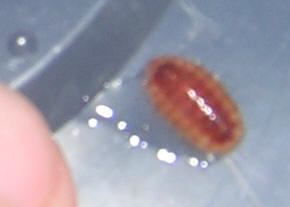 An isopod. An isopod.
|
Question about an Isopod in my Tank. Hi, I have recently
cycled my tank and I am noticed tons of these little guys running
around my tank. They seem to hang around the back wall and
on the glass. <Thus far> I recently moved and I have
all my fish in a 100 g Rubbermaid stock tank for the last 3 months
during the setup and cycling of my new tank. I put 300lbs of
Fiji rock into the tank to start a new system. I am ready to start
adding my fish, but I am extremely worried that I might have the BAD
isopods and I do not want to expose my fish to them. <Me too> I
have some pictures of the creatures as well as a thread I started on
reefcentral.com trying to get some information about them. I
got some responses but nothing definite. If you could please
take a look at the thread, here you can download the images and
possible, hopefully let me know if I am ok or not. I really
want to put my fish into the new system but I don't want to hurt
them. <Will look> I know you guys are extremely busy,
but if you could take a quick peek and maybe get back to me today that
would be extremely awesome! I met Bob Fenner at a talk he
did here in Colorado at Marine Showcase. I think he would
remember me, my company is designing and building the website for
Aqua-Medic USA. <Ah yes, I recall> Here is the link to that
thread: <A href=" http://reefcentral.com/forums/showthread.php?threadid=196239">http://reefcentral.com/forums/showthread.php?threadid=196239
> Thank you, John Michael <I would try a "test fish"
here... perhaps a damsel or two... to see if this species of isopod is
a "fish eater" or no. Bob Fenner>
Re: Question about an Isopod in my Tank. Did you find
anything out yet? :) John <No definitive way (from a pic) to tell
the habits of this isopod species... hence the suggestion to try
"test fish" at this juncture. Bob Fenner>
Re: Question about an Isopod in my Tank. Hi, Is it true that
only one kind of isopod can roll up like a ball, like a rolly polly
bug? I found this in an article and the kind that can are
scavengers. Mine roll up into a ball. John <Do think many
can roll up... a defensive mechanism. Bob Fenner> Sweetlips
Isopod I saw your article "Grunts, Porkfish &
Sweetlips" online and your photograph of a Diagramma pictum with a
couple of parasitic isopods on its head. Did you collect any
of these isopods? <No, just took the picture> Would
you like to have them identified? When was the photograph
taken? <In Pulau Redang, Malaysia, about two years ago> Thank
you. Bert Ernest H. Williams, PhD, Prof., Dept. Marine Sciences, Univ.
Puerto Rico <Thank you for your interest, offer. Bob Fenner>
| Critter IDs Please, with photos
attached The first photo is of a worm that looks like a
Bristleworm, but has some differences. <agreed... is
Polychaetous, but not specifically a "Bristleworm".>
Have seen this 3" worm on the glass of my 42 gal reef a few
times during the day. Doesn't look like a Bristleworm because
of the "mop" head, and BWs don't usually come out in
broad daylight. Photo taken at 4:30 pm, just around feeding
time. There appears to be no damage to corals or fish in
the reef this worm is in. <I frankly have no idea what this worm
is but am comfortable that most are overwhelmingly safe if not
useful as scavengers. You might send that pic to Dr Ron Shimek over
on ReefCentral.com (he has his own forum)> The last three photos
are of three bugs we sucked out of a well established 72g reef in
which had recently lost all our new fish, mostly dwarf and larger
angels. <my friend... please (!) do be careful.
Watch your own hands in this tank. They are parasitic isopods and
actually can nip/bite you. We have some data on our WetWebMedia
site about them as well as in our Reef Invertebrates book. Much
abroad on the net too about them. Treatment is possible but an
effort> Ammonia, nitrite and nitrate in the tank at the time of
the last fish death were 0 ppm. Had the flashlights out
the other night and these bugs were swimming about near the front
glass, though some were walking on the sandbed at times. Looks like
some kind of isopod, but I cannot say for sure from all the
research I've done if they are parasitic or not.
<they appear to be to me> The bugs were about 1/8th of an
inch in length when first caught. Have since set up a 5g tank with
LR, sandbed and macroalgae from reefs that do not contain these
bugs and have added a green Chromis to determine if the bugs will
infest the fish. Over the week the fish has been in the
5g, the bugs have grown twice their original size, have been seen
on the glass and sandbed, and the Chromis remains
healthy. <the Chromis for now may be too small
and/or fast> Currently in the 72 gal, at night, there are
pinhead sized bugs on the glass that look like the young of the
three bugs now in the 5g. Can you please ID the worm?
<I'll call him Joey> Also, can you tell from the photos
of the bugs if they are parasitic? <seems so yes> If they
are, I imagine a long period of time, say 2-4 months, without fish
would eliminate these bugs if they are parasitic and have no hosts.
<actually... they are on record going over 6 months and still
surviving> It has been 3 weeks since the last fish
died. During the fallow period I am continuing to feed
the tank daily to maintain high levels of nitrifying and
denitrifying bacteria until the time we will stock the 72g with
fish again. TIA for your time and consideration. Beverly
<wishing you the best of luck my friend. Anthony> |
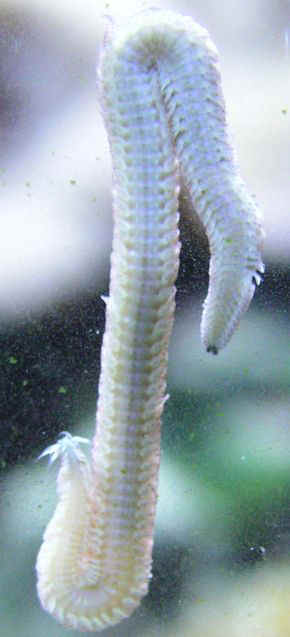 |
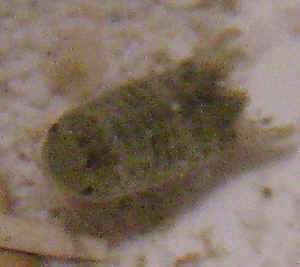 |
| Thanks, Dr. Ron! (A Happy Ending) Scott,
<Hi there again!> I wanted to let you know that the bugs pics
I sent you were IDed by Dr. Shimek as Sphaeromatids and are
harmless. The Chromis in the 5g test tank did not become
infested with them in the three weeks they were
together. All is good :) Thanks for your time
:) Beverly Edmonton AB Canada <Well, no one likes a happy ending
more than me! Glad that Dr. Ron was able to ID these little
creatures for you! Onwards! Regards, Scott F.> |
| Critter IDs Please 12/12/03 Anthony, I
wanted to let you know that the bugs pics I sent you were IDed by
Dr. Shimek as Sphaeromatids and are harmless. The
Chromis in the 5g test tank did not become infested with them in
the three weeks they were together. All is good
:) Thanks for your time :) <much thanks fo0r sharing
this, Beverly. I will be sure to reference it and consider. Thanks
kindly, Anthony> |
Isopod identification continued Hello, As
always thanks for all the help, answers and ideas you
provide. I just need some help identifying what type of
Isopod?? this is as I am 1 week away from moving my Liverock to my
main display tank and noticed these creatures. I have be
unable to tell if they are the Sphaeromatids, Cirolanids, or
Aegids? I have attached 2 photos to help. Please help as I would
rather fight them if needed in the QT tank then in the Main
display. << I wouldn't hesitate to add them to my
tank. I think you'll be fine. Your other
email with references to the Reefkeeping article was
helpful. I think the author of that article could be of
value here. >> Thank you for you help. Mark
<< Blundell >> |
| Isopod identification Just thought you would like to
know that I was reading the Reefkeeping issue http://reefkeeping.com/issues/2002-05/rs/index.htm
and noticed the following in regards to Sphaeromatids "They
can be recognized immediately by a couple of distinctive
characters. First, each individual has the capability to roll into
a ball-like terrestrial pill bug. None of the other isopods likely
to be found aquaria will be able do that." So I decided to try
see if I could get a couple of them I have in a container to roll
up. After about 2 seconds of touching them with a zip tie I was
able to get all 3 of them to roll up. Does that mean that they are
definitely are "Sphaeromatids" or is it still possible
they are "Cirolanid". << Well that is a way tough
question. I would be tempted to contact the author of that
Reefkeeping article and ask them about it. Sounds to me
like they are Sphaeromatids. >> Thanks for you assistance in
identification.
<< Blundell >> |
|
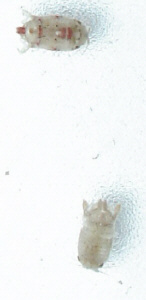
|
| Isopod identification continued Just wanted to let you
know that I contacted the author or the article below "Dr.
Ron" at ReefCentral and he confirmed that these are
Sphaeromatids. << Sounds good. >> As always thank you
for your assistance. << Glad you got it all worked out.
>> Mark << Blundell >> |
|
ID Needed 8/13/07 Hi. This little creature from the
coast of Maine (Bailey Island) on a mussel shell is 3.7mm long.
Can you please ID? Thanks, David Reed <Interesting... appears
to be a crustacean of some sort... any chance for an image of the
underside (to show its legs?)... almost looks like a juvenile
Limulus with the single trailing "tail". Bob Fenner>
Re: ID Needed 8/13/07 Here are a couple more
shots taken when it crawled onto my finger. David <Ahh! Does
appear to be an Isopod here. Bob Fenner>
Re: ID Needed 8/14/07 Yes, indeed. A
relative of the terrestrial sowbug. Thanks, David <Ah yes...
my brief pitch here re these Rolly Pollies:
http://www.wetwebmedia.com/isopoda.htm BobF> Thanks. Very
helpful.
David
<Welcome David. BobF>
|
|
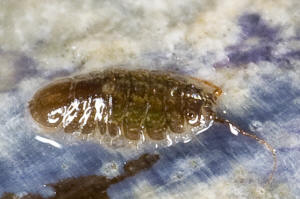 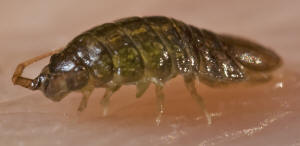
|
| Creature Id - Sphaeromatid Isopod -
8/8/07 Hi, guys. <Hi Jason> I've been reading on your
site for a long time and it has been very helpful to me. <Always
good to hear!> I have found something that I cannot identify and
I was wondering if you could help. <Hope so> I am including a
picture and a link to my YouTube videos to see it in movement.
<That's great, thanks!> It looks like some sort of bug.
<It certainly does, doesn't it?> It lives in my refugium
and is about 3/8 inch in length with a tan colored segmented body.
It has many tiny legs under its body which it uses to crawl around
in my Chaeto and two large spike appendages on its posterior
section. It has two little black beady eyes <Heee!> and I
can't find info anywhere. Can you help? <Yes! Its an isopod
(and a male, at that) in the Family Sphaeromatidae, otherwise known
as a Sphaeromatid.> Is it OK to have? <Yep, these are
harmless little scavengers.> Have I found something new?
<Heee! Well, indeed it may be new to your tank! Please see this
link for more info:
http://www.reefkeeping.com/issues/2002-05/rs/index.php. Also,
halfway down the page at this WWM link, see query titled Critter
IDs Please, with photos attached:
http://www.wetwebmedia.com/isopodfaqs.htm . You can clearly see
those beady little eyes you referred to!> Thank you Jason
<You're very welcome, and enjoy! -Lynn> Video links...
http://www.youtube.com/watch?v=fI4ulf8rDdc
http://www.youtube.com/watch?v=znaUnSXTAhA |
|
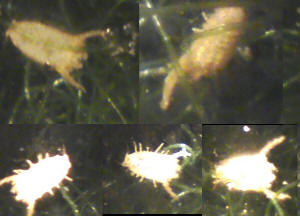
|
Satan... is an Isopod? 7/17/07
Bob, I swear, if I believed there was a Satan, I imagine this is what
s/he would look like:
http://www.quartzcity.net/wp-content/uploads/2006/10/giant-isopod.jpg
;-) Sara <Heeee! Can you imagine being on the deep sea floor bottom
with a whole bunch of these ginormous rolly pollies!? No thanks!
B>
|
Crazy Bug?? Isopod ID 7/13/07 Dear Crew,
Happy Friday. I found this bug swimming frantically around my
tank this morning before the lights came on. This thing is
BIG--like 3/4" long. It does not appear to be an
amphipod--almost looks like a sand flea that one finds at the
beach. <Ugh, heaven have mercy, it's an isopod. I'm
not an isopod expert, so I can't tell you for sure if
it's an Aegid or Cirolanid, but my money is on Cirolanid. In
any case, they're horrid little creatures. Granted, many of
them are scavengers. However, unlike the happy bristle worm
scavengers, many of them have the propensity to turn into
blood-sucking little horrors if they get hungry enough. Other
species are actually obligate blood sucking parasites (which
means they have to feed on the blood of your fish... or your
blood even). And they're crafty too. Many of the parasitic
ones will only attack your fish at night when you're not
looking. So your fish can slowly die of anemia before you ever
see them. I know this might all sound like a bad camp-fire horror
story, but it's true. And do keep your hands out of the tank
at night. They don't always know a fish from a human and
blood is blood. ;)> Can you ID it for me and tell me whether
it's good or bad and where it came from (I presume my live
rock)? <It's most likely bad or could become bad. And yes,
it probably came in on live rock. How do your fish look? If you
see any spots on them or if they start to look sick, you could
have a serious problem.> Thanks! <De nada, Sara M.> Andy
Re: Crazy Bug?? 07/14/07 Sara, Based on
the pictures contained in the following webpage, I think my blood
sucking deviant is an Aegid Isopod.
http://www.reefkeeping.com/issues/2002-05/rs/index.php <Yep,
that's a great article and the one I referred to after seeing
your bug. I can see why you'd say it's an Aegid. Maybe it
is. But look at the shape of the final segment, it's more of
a triangle and pointy (like the Cirolanid). And look at where the
eyes are on the first segment. The Aegid's eyes seem to go
past the first segment into the second segment whereas the eyes
of the Cirolanid stay within the first segment. But anyway, we
could probably talk about this all day and still not know for
sure. Like I said, it takes someone with a more intimate
knowledge of isopods to be certain. But I will look for such a
person and see if we can't settle this. :-) In any case, I
think both types are probably equally vile. Best,
Sara M.>
|
|
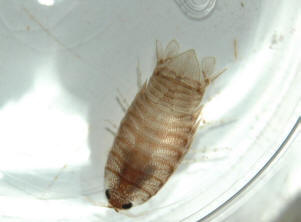
|
|
Mystery pod
5/24/07 Hello there, <Hello to
you> I purchased copepods from a supplier and received this
isopod in the bag. The guy states that it will only
eat algae <Mmmm> but I am worried that the bag of copepods
might have smaller ones and I won't be able to see them for
awhile. I didn't put the bag of pods in my tank.
<Not this one I hope/trust> I am trying to culture them for
my mandarin. Here are some pics of this creature. It
doesn't look like a Cirolanid because it seems to have long
appendages on the back same as with the Aegid. I am
wondering if it is a Sphaeromatid. Thank you for your assistance.
Cher <This could be a member of any of these three families. I
would exclude it from your system. Bob Fenner>
|
|

|
|
Re: mystery
pod 5/24/07Hi Bob, If I
mail it to you, would you be able to tell what it is then? Cher
<Mmm, better to call around the local college/s... that have
an organismal Bio. or better, Zoology Dept.... See if someone
there does much with Isopod Taxonomy. If not someplace close,
I'd check the Net re who you might mail it to... ask how to
preserve... Bob Fenner>
|
Re: oh, and good luck, Isopod ID 5/24/07
Good luck finding someone to ID isopods!!! I did a summer of that
as fresh marine biology graduate for an environmental survey
company. And isopods were possibly the worst things to ID.
I'm impressed if a layman can get them down to family level by
eye; even with a microscope doing much better than genus was often
impossible. Cheers, Neale <Ah, yes... I sorted and Id'd benthic
marine invert.s (mainly Errantiate Polychaetes) locally for a couple of
years as a grad student... Some eye strain now! BobF>
-Possible Isopod issues- 1/20/06
Hello all! <Hello, Justin with you this evening.> First of all,
THANK YOU so very much for your amazing site! It is such a
wealth of fantastic information, and is truly (in my humble opinion)
the best wet-pet resource on the web! <Well its all due to many
people who help, and the crew here. Ill pass your thanks on to Bob.>
I currently maintain a 120G fish-only tank. In addition to
the 3" puffer (Diodon holocanthus), there is also a 4" angel
(Pomacanthus imperator), 4" lion (Pterois volitans) and a couple
of small (1-1.5") damsels. Salinity - 1.021, Temp -
80*F, Ammonia - 0, Nitrites - 0; Nitrates - 5ppm. <An interesting
mix, have you seen any aggression out of the Lionfish? most
of the time puffers, and lions may squabble, much to the lions
detriment when the puffer breaks off spins or nips fins. do
keep an eye out for long term issues. You also will probably
need a bit bigger tank long term for these guys as all the fish get to
15" + other than the damsels.> A couple of days ago, I noticed
a small white spot medial to my puffer's left eye. The
spot does not look like Oodinium or ick, but is rather large (2-3mm)
and flat. This morning, I noticed two more ventral spots...
also 2-3mm each, flat, and completely circular! They do not
look like any sort of parasite that I know of, and it seems very
strange to acquire trauma with those manifestations. Also,
the spots are bright solid white, and almost appear
"indented" into the skin. What on earth could this
be? <The indented part seems very odd, as most parasites are bulges
outward or bumps. It may be an isopod of some sort that has decided to
attach on. they can be fairly easily treated in hypo salinity dips or
by using a anti parasite medicine in a hospital tank for a few
days. However, From what you are saying it is hard to give
you a definite answer on it. Can you maybe send in a good
photo of the area in question. It would be much more helpful
in identifying the culprit if one exists. Also herding the
puffer into a container and gently rubbing the area to see if it comes
off or is an actual indentation may save you further headache
here. My puffer enjoys digging up substrate (I have sand)
and little pieces get stuck in the spines and look very odd and are a
similar size to what you are saying. Also mine enjoys
playing in the sump return pipe and getting micro bubbles all over him
as well. It could be a benign item like that.> His
attitude is perky as always, and he is eating great! I am at
a loss on this one... any ideas? <You have me a bit stumped as well
on this, but Id check the basics first, and a gentle rubbing of your
finger on the area may reveal a simple answer to your
concern. Try watching it for now and see if any more appear
or if they disappear all together. I will forward this to Bob for some
further ideas. If you can grab a photograph of the area and
send it in as I said above, it may be much more telling.> Thanks in
advance for everything! Christine <Thank you for being clear, and
including everything tank wise I needed to know to focus on the
issue. Hope we can figure this out.> <Justin
(Jager)>
| Clownfish mouth... Isopod? What's up? I greatly
appreciate all of your time, help, and effort with the site and the
mounds of info you guys supply. I have attached a picture of
my TR gold stripe maroon clown. I just noticed the
"thing" in his/her mouth yesterday and today it appears
the same. I have had him/her for a year and he/she still acts the
same and feeds with the same manors. Also there are no other marks
on his/her body. To me, it appears to be a fungus or possibly a
deformity in the jaw. Any info you can supply would be great and
hopefully I e-mailed the picture correctly. If there is any other
info I can supply please let me know because this is a great fish.
90 gallon 120 lbs of live rock 7 LPS xenias Schuran skimmer 30
gallon refugium 1 Powder Blue 1 Gold Stripe Maroon Thanks again,
Greg <Not quite clear, but your Clown may well be infested with
an Isopod. Please see here: http://www.wetwebmedia.com/isopoda.htm
Tough to extract, but if you want to give this a try, you'll
need help, holding the fish... and with forceps, extracting the
crustacean from the "tongue" bone of the Clown... can be
done with or w/o anesthetic... Bob Fenner> |
|
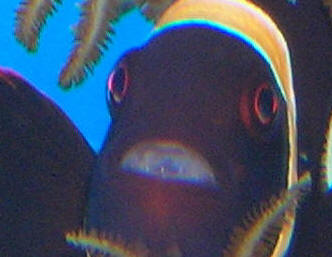
|
SW hitchhiker thing Hello gang, <Bryan> Hope all is
well. I have a small 20g tank with a 2-1/2" Taenianotus Leaf
Scorpion. Tank parameters are temp: 76-77F, NH3:0, NO2:0, NO3:20,
Sal:30. Co-habitants include many Columbellid snails, 2 or 3
Clibanarius hermits, 1-1/2" Mithraculus type crab, Zoanthid
polyps, a bundle of Chaetomorpha, and the usual micro/macro
tag-a-longs. Filtration is by AquaC Remora and 25% IO water change
weekly. The fish did a 4 week QT, no copper, no hypo or F/W dip. The
rest of the tank (including live rock) was directly introduced. I noted
this character on the surface film, 1/8" in diameter resembling a
small freshwater Argulus louse. It breaks the surface tension and
begins floating downward. I can see a swimming or oscillating motion
but the sucker descends in a straight path... until it contacts the
Leaf Scorpion and gloms onto the fish's side. The Scorpion reacts
by doing its side-to-side thing. By morning, the little arthropod-y
thing is gone. So... Is this little creature familiar to anyone? I
realize the description is vague and pictures non-existent but was
hoping that it is a common, non-pathogenic fellow. I will also check
with Shimek. Thanks Bryan <Is it grey/ish in color... Please see
here: http://www.wetwebmedia.com/isopoda.htm.
Bob Fenner>
Unidentified Creatures, Friend Or Foe? - -05/07/05 Dear WWM
crew, Although I haven't heard back from you with regards to my
last e-mail, I did in fact find a picture on-line of my mystery
creature and I'm afraid it isn't good news. It's
described as a my isopod although Google didn't give me any links
when I tried that word. I've attached the picture to
this e-mail. The website for Tampa Bay Live Rock is where I
found this picture and they recommend that you remove it immediately as
it will act as a fish parasite. Do you know anything about
these creatures? <What you have is an "isopod"...I believe
the "my" was used to show possession as in
"hey! That's my isopod"
<G>. These organisms are indeed parasitic, have a read
here http://www.wetwebmedia.com/isopodfaqs.htm
and on the associated links in blue.> Thank you again for everything
that you guys do! Best wishes, Karen <Regards, Eric R.>
|
What is It?? Anthony's "MicroCrusty"
Hi, Bob... just wondering if you have a notion what this
microcrusty might be? They are rather common in fishless
tanks/refugia... and usually succeed Amphipods. Their size is
only slightly smaller than Gammarus, for example. I sent the pic
to Rob T in Hawaii, but he was not familiar. Any ideas?
Anthony C. <Don't know either... though looks vaguely
familiar. Let's post on WWM and ask. BobF>
Grazie :) And a bit of a mention... those mantis like aspects in
the front are only developed on larger specimens. The smaller
individuals tend to get described like "centipedes"
commonly (that is to say... they are very symmetrical... elongate
with bullnose ends and sparse large legs. Hard to tell heads from
tails when small) Anth- <Yeah, the fancy mouthparts reminded
me of the Odonata. B>
Follow-up question re: What is It??
Anthony's "MicroCrusty": Munnid - 3/3/08 Crew,
<Hi Russ> First, I'd like to thank you for all you do
for this hobby. All of you have greatly contributed to my success
as an aquarist (through this site, your books, etc.). <Ah,
that's music to our ears. On behalf of Bob and the crew past
and present, I thank you very much!> My "question"
is more of a follow-up to one previously asked. It pertains to
the post titled "What is It?? Anthony's
"MicroCrusty""
(http://www.wetwebmedia.com/crustidfaqs.htm, about half-way down
the page). I would like to know if anyone has made an ID on this
critter. <Yes indeed, its a harmless, beneficial, herbivorous
little isopod in the family Munnidae, commonly called a
Munnid.> I have searched everywhere I know to, and this post
is the only place I can even find it mentioned. I have an
abundance of these critters in my tank and refugium. They seem to
thrive just about anywhere; on glass, in the sandbed, on LR, and
throughout my Chaeto. <Yep, thank goodness they're good guys,
huh!> They do not appear to predatory, as I have never noticed
them disturbing any of my tank inhabitants (various fish, corals,
sponges, crustaceans, etc.). <That's correct. Unlike their
Cirolanid cousins, these pose no threat to livestock and in fact
serve as tasty fish treats.> I do occasionally see them
squabble amongst themselves, or with the copepods and amphipods,
<Yes, it seems to be in their nature and it always makes me
laugh to see it in action. Have you seen them perform their
little dance yet? In the photo at that link (taken from
underneath the Munnid) you can see two anterior appendages folded
up under the body, akin to a Praying Mantis. Occasionally, two
Munnids will face off, extend those two surprisingly long
appendages out towards each other, grasp tips, and do an odd
little dance. It lasts for several seconds then they release and
go their separate ways. Why they do this, I have no idea, but it
is interesting and amusing to see. Its probably the Munnid
equivalent of You're on my property!. By the way, here's a
dorsal/top view of one that was in my tank:
http://wetwebfotos.com/usermedia/high/0/2470_145.jpg .> ..but
I have never witnessed anything serious come of this (death,
predation, etc.). <Nope, their squabbling always seems to be
brief/not very intense.> Also, my Synchiropus splendidus loves
to eat these guys. <I bet he does!> He actually appears to
prefer them over copepods or amphipods. This may be due to the
fact that they are much larger than the copepods (easily 10-15x),
and seem easier to catch than the amphipods. <Heeheeee! Or
maybe they just taste better! Seriously though, I agree with your
assessment. Of the three main choices (copepods, Munnids,
amphipods) Munnids are right smack dab in the middle, size-wise.
They're perfect for little Synchiropus/Mandarin fishes.> They
are able to "run" quickly, but only do so in short
bursts, and they do not seem to have any swimming ability.
<Nope, they are decidedly more adapted to crawling than
swimming. The only time I've ever see one even attempt it is when
I've accidentally dislodged it while cleaning the glass. Graceful
swimmers, they are not!> My only concern is that I am not sure
how nutritional they are. I am not too worried about this,
because they seem to have the same feeding habits as my other
pods. Also, the mandarin has always been quite plump, colorful,
and active. <Yep, I wouldn't be concerned. I imagine that
nutritionally, they're about on par with copepods and
amphipods.> That pretty well sums up my observations on these
guys. <Very impressive, indeed! Its always such a pleasure to
find someone who appreciates the smaller, but no less fascinating
creatures we have in our tanks. :-)> I hope this has been
somewhat informative, or at least interesting to read. <Very
much so.> I welcome any/all comments you all may have, even if
an ID is not possible. Thanks again for all you do. Russ <It
was a pleasure, Russ, and thank you for sharing your
observations! Take care, -Lynn>
|
|
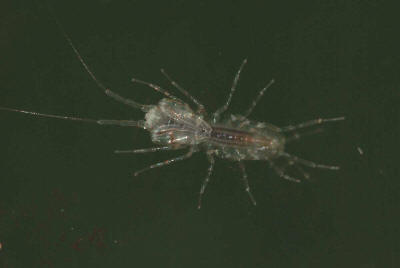 Here tis' Here tis'
|
|
|

